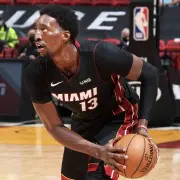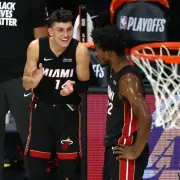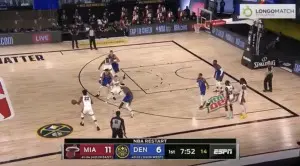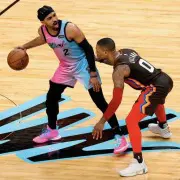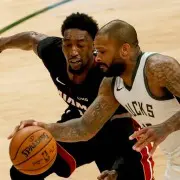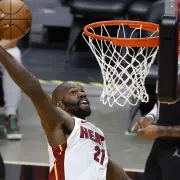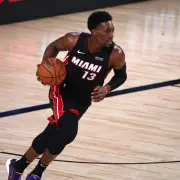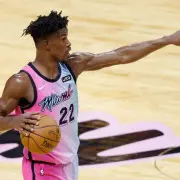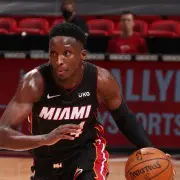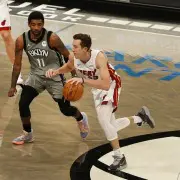The Importance of Elbow Touches in Heat Offensive Scheming
When a team doesn’t have a true play-making point guard to run the show offensively, there’s always a slight change of pace in terms of the way they trigger actions. Luckily for the Miami Heat, a young play-making big like Bam Adebayo makes the game-plan pretty clear heading into a season.
There’s two ways that he has been highly effective as a passer within the team’s offensive sets: 1) Creating on the move following the roll on the screen and 2) Setting up on the elbow.
Adebayo really began to take some major offensive leaps when his shooting reluctancy faded slightly and grew comfortable with taking shots in the mid-range area. That led to a very high frequency of elbow touches for him this past season.
Kyle Lowry being added to this roster definitely takes away some play-making duties from Adebayo in those spots, but it definitely doesn’t change his overall usage in that area.
Why not look back at Adebayo’s scoring masterclass, putting up 41 points against the Brooklyn Nets in a multitude of ways. He wasn’t doing it in ways that most bigs acquire 40 points in this league. He was doing it like a skilled perimeter player.
Facing up at the elbow and flying in plenty of different directions. Jab steps immediately into a jumper, swiping through for clear paths to the rim, and shot creating in ways we truly hadn’t seen up to that point.
Those are the elbow touches many want to see from Adebayo. He no longer has the pressure to play-make over the top of the defense for simple sprays or back-cuts, even though he will still sprinkle that stuff in due to his unselfish mentality.
But it’s now about opening up the scoring role from that spot in true Barclays Center fashion.
It’s not even just about him putting the ball in the basket, since it’s much more about the big picture effectiveness of a Heat offense. As stated in the past, we’re going to see a lot more diversity in this motion offense with the new weapons added to the roster. So, it’s up to him to maximize the spacing in that environment.
If he can add any bit of stress to help defenders when he stations himself at the elbow or free throw line, that’s an automatic win for the Heat. Once he builds the scouting report for teams to double him in that area so he can’t iso bigs inside the arc, the play-making opens right back up, which is the ultimate goal.
It shouldn’t be picking times to play-make and picking times to score. It just has to be natural. And if the surrounding spacers can do their job consistently, I have no doubt that Adebayo will flow much more naturally with those elbow touches next season.
Now, when talking about offense being run through the elbow, this isn’t just an Adebayo topic, even though it’s necessary to start there. A bunch of different players can benefit from this, and it begins with Kyle Lowry.
Looking at the play above, this is something Toronto did a lot of last season, using Lowry in more than one way in this specific action. Fred VanVleet inserts the ball to Lowry in a high post position, which sometimes will be a bit lower on the floor, before sprinting into a pin-down for a good look from three.
When seeing this, I bet many of you are picturing Duncan Robinson in that spot. But well, I’m not sure I agree exactly.
Robinson is a unique player in terms of the way he is guarded. As we saw last years, simple pin-downs just aren’t really going to work for him anymore with the amount of attention that he gets on a regular basic.
Tyler Herro, on the other hand, fits this set perfectly.
The Lowry-Herro back-court is an interesting one when projecting forward, due to the fact Lowry can enhance the one skill of Herro’s that he struggled with this past-season: spot-up threes.
Inserting him into these sets allow him to get good catch and shoot looks early on, which may be one of the most important stat-line improvements for this Heat team to have success. Combining Lowry’s wide frame and passing ability in these spots of the floor is very intriguing from a game-planning perspective.
Now, as mentioned previously, they’re going to shift Lowry around a bit. He’s an incredible player off the ball as a spot-up shooter and decoy, meaning these pin-downs can be the set up for him above the break. And well, it isn’t the worst thing in the world to put Jimmy Butler in high post positioning for play-making.
His downhill gravity when facing up always attracts those corner defenders. So if they jump that pin-down action, it means plenty of open space to navigate as an attacker, or potential lob pass to the roller off that initial screen.
Loading...
Working things through the elbow will mostly be seen in a similar way next season, except it’ll be used completely different. The mind-set and go-to moves in that spot will be changing for each player who fills up that area of the floor.
And once again, all of these pieces on the Heat’s offensive scheming come back to the same point: the effectiveness will largely ride on the shooting of their corner spacers. If this team makes defenses pay on open corner sprays, it changes the entire offensive dynamic in both the regular season and post-season.
Everything Tradeshows is a one-stop-shop for trade show exhibit rentals and custom exhibit display purchase solutions to companies of all sizes.
Visit them at EverythingTradeShows or call 954-791-8882
